Seismic Vulnerability Assessment of a Medieval Urban Cluster Identified as a Complex Historical Palace: Palagio di Parte Guelfa in Florence
Abstract
:1. Introduction
2. Palagio di Parte Guelfa in Florence
2.1. The Knowledge Path
2.1.1. Historical Evolution
2.1.2. Architectural and Structural Survey
2.1.3. Thermography Campaign and GPR Survey
- − Compact and homogenous mixed masonry
- − Non-homogenous mixed masonry characterized by the presence of cavities and rubble stones with variable dimensions
- − Masonry with double leaves and an inner nucleus
2.1.4. Sonic Tests and MD Campaigns
2.2. Identification of the Structural Units
3. The Seismic Vulnerability Assessment
3.1. Definition of the Seismic Demand
3.2. Vulnerability Assessment
4. Conclusions
- (i)
- the Palace was not designed in accordance with seismic codes, but rather, based on empirical assumptions; the big dimensions of the buildings do not give rise to box behavior;
- (ii)
- the different macroelements tend to behave independently.
- (iii)
- the important class function of the palace increases the seismic demand
Author Contributions
Funding
Institutional Review Board Statement
Informed Consent Statement
Data Availability Statement
Acknowledgments
Conflicts of Interest
Appendix A

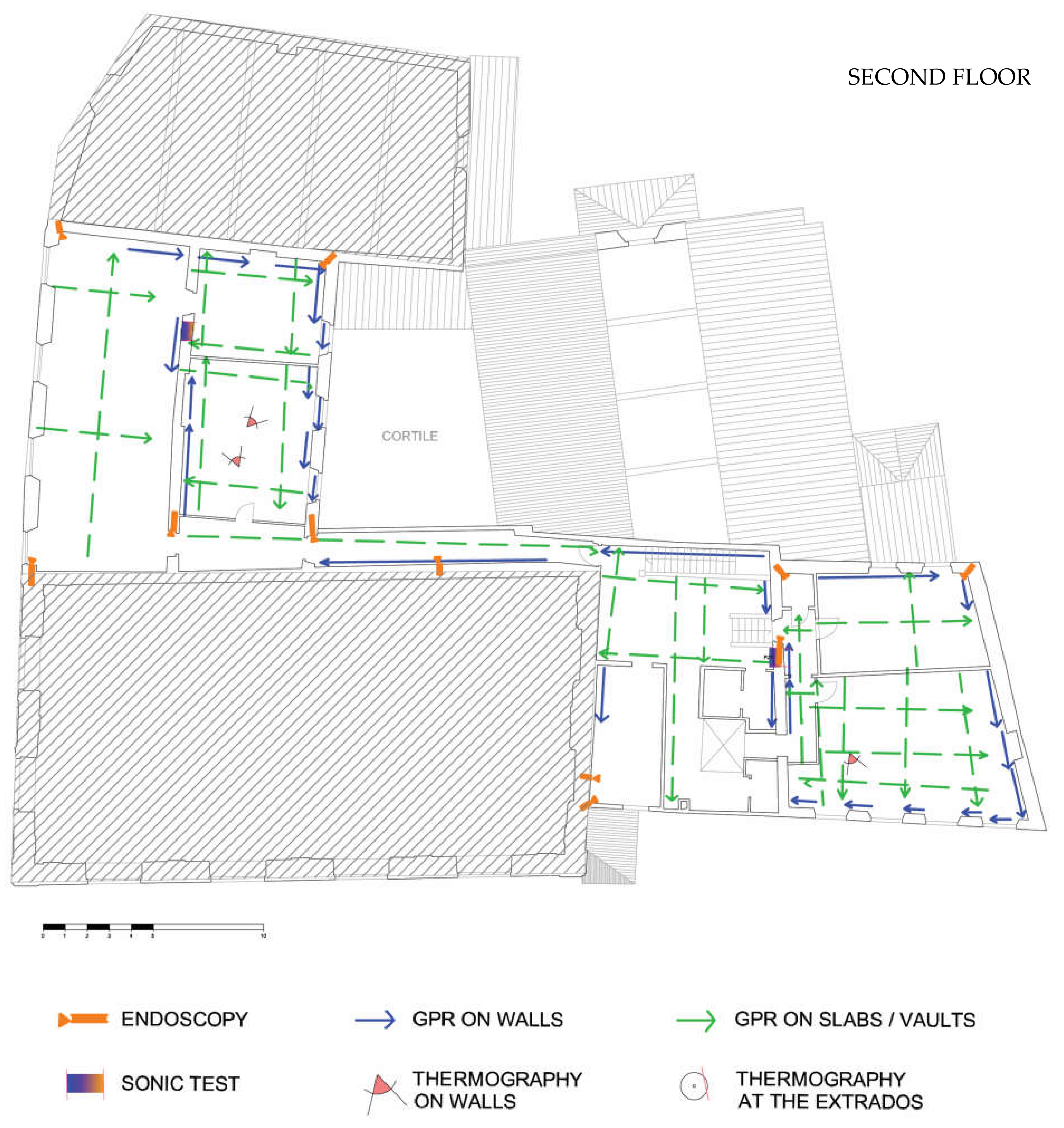
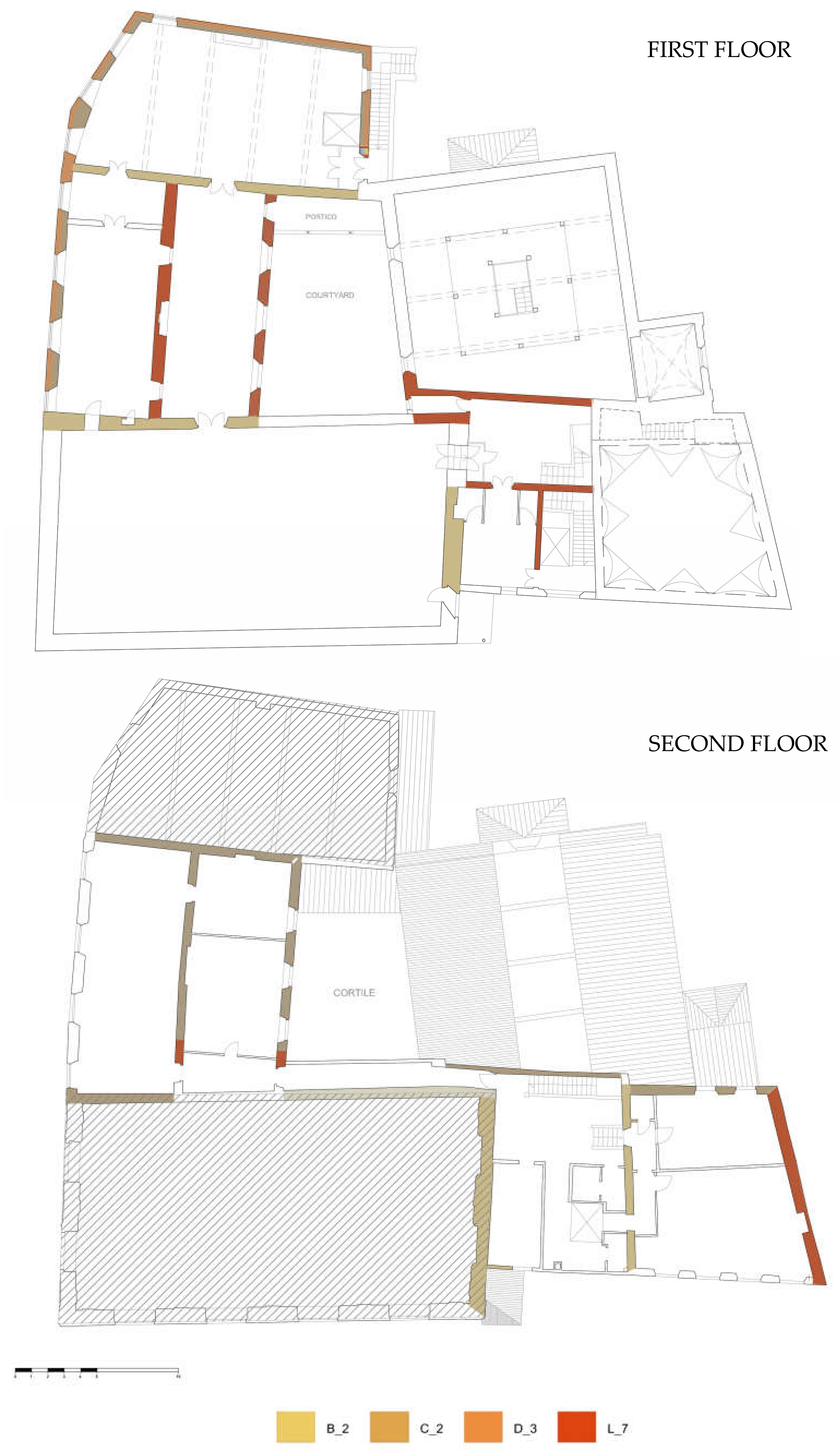
References
- ICOMOS. Principles for the analysis, conservation and structural restoration of architectural heritage. In Proceedings of the ICOMOS 14th General Assembly, Victoria Falls, Zimbabwe, 27–31 October 2003. [Google Scholar]
- Pecchioli, L.; Panzera, F.; Poggi, V. Cultural heritage and earthquakes: Bridging the gap between geophysics, archaeoseismology and engineering. J. Seismol. 2020, 24, 725–728. [Google Scholar] [CrossRef]
- Didier, M.; Baumberger, S.; Tobler, R.; Esposito, S.; Ghosh, S.; Stojadinovic, B. Improving post-earthquake building safety evaluation using the 2015 Gorkha, Nepal, Earthquake rapid visual damage assessment data. Earthq. Spectra 2017, 33, 415–434. [Google Scholar] [CrossRef]
- Di Ludovico, M.; De Martino, G.; Prota, A.; Manfredi, G.; Dolce, M. Damage Assessment in Italy, and Experiences After Recent Earthquakes on Reparability and Repair Costs. In Advances in Assessment and Modeling of Earthquake Loss; Akkar, S., Ilki, A., Goksu, C., Erdik, M., Eds.; Springer Tracts in Civil Engineering, Springer: Cham, Switzerland, 2021. [Google Scholar] [CrossRef]
- Stepinac, M.; Lourenco, P.B.; Atalić, J.; Kišiček, T.; Uroš, M.; Baniček, M.; Šavor Novak, M. Damage classification of residential buildings in historical downtown after the ML5.5 earthquake in Zagreb, Croatia in 2020. Int. J. Disaster Risk Reduct. 2021, 56, 102140. [Google Scholar] [CrossRef]
- Roca, P.; Lourenço, P.B.; Gaetani, A. Historic Construction and Conservation: Materials, Systems and Damage; Routledge: London, UK, 2019. [Google Scholar]
- Varum, H.; Rodrigues, H.; Lourenço, P.B.; Vasconcelos, G. Seismic behaviour of vernacular architecture. In Seismic Retrofitting: Learning from Vernacular Architecture; CRC Press: Boca Raton, FL, USA, 2015; p. 151. [Google Scholar]
- Lourenço, P.; Varum, H.; Vasconcelos, G.; Rodrigues, H. Structural conservation and vernacular construction. In Seismic Retrofitting: Learning from Vernacular Architecture; CRC Press: Boca Raton, FL, USA, 2015; pp. 37–42. [Google Scholar] [CrossRef] [Green Version]
- Lagomarsino, S. On the vulnerability assessment of monumental buildings. Bull Earthquake Eng. 2006, 4, 445–463. [Google Scholar] [CrossRef]
- Lourenço, P.B. Computations on historic masonry structures. Prog. Struct. Eng. Mater. 2002, 4, 301–319. [Google Scholar] [CrossRef]
- D’Altri, A.M.; Sarhosis, V.; Milani, G.; Rots, J.; Cattari, S.; Lagomarsino, S.; Sacco, E.; Tralli, A.; Castellazzi, G.; de Miranda, S. Modeling Strategies for the Computational Analysis of Unreinforced Masonry Structures: Review and Classification. Arch. Comput. Methods Eng. 2020, 27, 1153–1185. [Google Scholar] [CrossRef]
- Lagomarsino, S.; Cattari, S. PERPETUATE guidelines for seismic performance-based assessment of cultural heritage masonry structures. Bull. Earthq. Eng. 2015, 13, 13–47. [Google Scholar] [CrossRef]
- Despotaki, V.; Silva, V.; Lagomarsino, S.; Pavlova, I.; Torres, J. Evaluation of Seismic Risk on UNESCO Cultural Heritage sites in Europe. Int. J. Arch. Herit. 2018, 12, 1231–1244. [Google Scholar] [CrossRef]
- MIBACT. Linee Guida per la Valutazione e Riduzione del Rischio Sismico del Patrimonio Culturale Allineate alle nuove Norme Tecniche per le Costruzioni (D.M. 14 Gennaio 2008), Rome. 2011. Available online: https://www2.ing.unipi.it/~a005843/Consolidamento%202016-17/Normativa/LineeGuida_BBCC_2010_11_26_1.pdf (accessed on 12 November 2022). (In Italian).
- Formisano, A.; Marzo, A. Simplifed and refined methods for seismic vulnerability assessment and retrofitting of an Italian cultural heritage masonry building. Comput. Struct. 2017, 180, 13–26. [Google Scholar] [CrossRef] [Green Version]
- D’Amato, M.; Sulla, R. Investigations of masonry churches seismic performance with numerical models: Application to a case study. Arch. Civ. Mech. Eng. 2021, 21, 1–26. [Google Scholar] [CrossRef]
- D’Amato, M.; Gigliotti, R.; Laguardia, R. Comparative Seismic Assessment of Ancient Masonry Churches. Front. Built Environ. 2019, 5, 56–73. [Google Scholar] [CrossRef]
- Betti, M.; Galano, L.; Lourenço, P.B. Territorial seismic risk assessment of a sample of 13 masonry churches in Tuscany (Italy) through simplified indexes. Eng. Struct. 2021, 235, 111479. [Google Scholar] [CrossRef]
- Cardinali, V.; Cristofaro, M.T.; De Stefano, M.; Tanganelli, M. Cultural heritage buildings and strategic uses: Seismic vulnerability assessment in Florence. Rehabend 2022, 1148–1155. [Google Scholar]
- Touliatos, P.G. Seismic behaviour of traditionally-built constructions: Repair and strengthening. In Courses and Lectures-International Centre for Mechanical Sciences; Springer: New York, NY, USA, 1996; pp. 57–70. [Google Scholar]
- Magenes, G.; Penna, A. Existing masonry buildings: General code issues and methods of analysis and assessment. In Eurocode 8 Perspectives from the Italian Standpoint Work Shop; Cosenza, E., Ed.; Doppiavoce: Napoli, Italy, 2009; pp. 185–198. [Google Scholar]
- Marques, R. Masonry modeling. In Encyclopedia of Earthquake Engineering; Beer, M., Kougioumtzoglou, I.A., Patelli, E., Au, S., Eds.; Springer: Berlin/Heidelberg, Germany, 2015; pp. 1419–1431. [Google Scholar] [CrossRef]
- Gilbert, M.; Casapulla, C.; Ahmed, H. Limit analysis of masonry block structures with non-associative frictional joints using linear programming. Comput. Struct. 2006, 84, 873–887. [Google Scholar] [CrossRef]
- Lagomarsino, S. Seismic assessment of rocking masonry structures. Bull. Earthq. Eng. 2014, 13, 97–128. [Google Scholar] [CrossRef]
- Ferreira, T.M.; Costa, A.A.; Vicente, R.; Varum, H. A simplified four-branch model for the analytical study of the out-of-plane performance of regular stone URM walls. Eng. Struct. 2015, 83, 140–153. [Google Scholar] [CrossRef]
- Giordano, N.; De Luca, F.; Sextos, A. Out-of-plane closed-form solution for the seismic assessment of unreinforced masonry schools in Nepal. Eng. Struct. 2020, 203, 109548. [Google Scholar] [CrossRef]
- Grillanda, N.; Valente, M.; Milani, G. ANUB-Aggregates: A fully automatic NURBS-based software for advanced local failure analyses of historical masonry aggregates. Bull. Earthq. Eng. 2020, 18, 3935–3961. [Google Scholar] [CrossRef]
- Sandoli, A.; Calderoni, B. Assessment of the seismic vulnerability at territorial scale: A new structural classification of existing buildings and definition of fragility curves. Proceedings of 10th International Masonry Conference (IMC), Milano, Italy, 1 July 2018. [Google Scholar]
- MIT. Circolare 21 Gennaio 2019, n. 7 Istruzioni per l’applicazione dell’«Aggiornamento delle “Norme Tecniche per le Costruzioni”» di cui al Decreto Ministeriale 17 Gennaio 2018. G.U. n. 47 del 26/02/2009; Supplemento Ordinario n. 27; Gazzetta Ufficiale: Rome, Italy, 2019. (In Italian) [Google Scholar]
- Bartoli, G.; Betti, M.; Blasi, C.; Ottoni, F.; Coli, M.; Marchetti, E.; Ripepe, M. Synergistic and Interdisciplinary Approaches for the Conservation of Monumental Heritage: Cupola of Santa Maria del Fiore in Florence, Italy. J. Perform. Constr. Facil. 2016, 30, 831. [Google Scholar] [CrossRef]
- Masciotta, M.-G.; Roque, J.C.; Ramos, L.F.; Lourenço, P.B. A multidisciplinary approach to assess the health state of heritage structures: The case study of the Church of Monastery of Jerónimos in Lisbon. Constr. Build. Mater. 2016, 116, 169–187. [Google Scholar] [CrossRef] [Green Version]
- Dall’Asta, A.; Leoni, G.; Meschini, A.; Petrucci, E.; Zona, A. Integrated approach for seismic vulnerability analysis of historic massive defensive structures. J. Cult. Heritage 2018, 35, 86–98. [Google Scholar] [CrossRef]
- Bento, R. An Interdisciplinary Approach to the Seismic Assessment of Built Cultural Heritage: Case Studies in Lisbon and Outskirts; Springer International Publishing: Cham, Switzerland, 2019; pp. 3–18. [Google Scholar]
- Cardinali, V.; Castellini, M.; Cristofaro, M.T.; Lacanna, G.; Coli, M.; De Stefano, M.; Tanganelli, M. Integrated techniques for the structural assessment of cultural heritage masonry buildings: Application to Palazzo Cocchi-Serristori in Florence. J. Cult. Heritage Manag. Sustain. Dev. 2021, ahead of print. [Google Scholar] [CrossRef]
- Adamopoulos, E.; Rinaudo, F. 3D Interpretation and Fusion of Multidisciplinary Data for Heritage Science: A Review. In Proceedings of the 27th CIPA International Symposium “Documenting the past for a better future, Avila, Spain, 1–5 September 2019; Volume 42, pp. 17–24. [Google Scholar]
- Binda, L.; Saisi, A.; Tiraboschi, C. Investigation procedures for the diagnosis of historic masonries. Constr. Build. Mater. 2000, 14, 199–233. [Google Scholar] [CrossRef]
- Pelà, L.; Roca, P.; Aprile, A. Combined In-Situ and Laboratory Minor Destructive Testing of Historical Mortars. Int. J. Arch. Heritage 2018, 12, 334–349. [Google Scholar] [CrossRef]
- Diz-Mellado, E.; Mascort-Albea, E.J.; Romero-Hernández, R.; Galán-Marín, C.; Rivera-Gómez, C.; Ruiz-Jaramillo, J.; Jaramillo-Morilla, A. Non-destructive testing and Finite Element Method integrated procedure for heritage diagnosis: The Seville Cathedral case study. J. Build. Eng. 2021, 37, 102134. [Google Scholar] [CrossRef]
- Coli, M.; Ciuffreda, A.L.; Donigaglia, T. Technical Analysis of the Masonry of the Bargello’ Palace, Florence (Italy). Appl. Sci. 2022, 12, 2615. [Google Scholar] [CrossRef]
- Binda, L.; Cardani, G.; Valluzzi, M.; Munari, M.; Modena, C. Multilevel Approach to the Vulnerability Analysis of Historic Buildings in Seismic Areas Part 1: Detection of Parameters for Vulnerability Analysis through on Site and laboratory Investigations. Restor. Build. Monum. 2007, 13, 413–426. [Google Scholar] [CrossRef]
- Caprili, S.; Mangini, F.; Paci, S.; Salvatore, W.; Bevilacqua, M.G.; Karwacka, E.; Squeglia, N.; Barsotti, R.; Bennati, S.; Scarpelli, G.; et al. A knowledge-based approach for the structural assessment of cultural heritage, a case study: La Sapienza Palace in Pisa. Bull. Earthq. Eng. 2017, 15, 4851–4886. [Google Scholar] [CrossRef]
- Maio, R.; Santos, C.; Ferreira, T.M.; Vicente, R. Investigation Techniques for the Seismic Response Assessment of Buildings Located in Historical Centers. Int. J. Arch. Heritage 2018, 12, 1–14. [Google Scholar] [CrossRef]
- Casarin, F.; Modena, C. Seismic Assessment of Complex Historical Buildings: Application to Reggio Emilia Cathedral, Italy. Int. J. Arch. Heritage 2008, 2, 304–327. [Google Scholar] [CrossRef]
- Lagomarsino, S. Seismic assessment of complex monumental buildings in aggregate: The case study of Palazzo del Podestà in Mantua (Italy). In Proceedings of the SAHC2014—9th International Conference on Structural Analysis of Historical Constructions, Mexico City, Mexico, 14–17 October 2014. [Google Scholar]
- Ciocci, M.P.; Sharma, S.; Lourenço, P.B. Engineering simulations of a super-complex cultural heritage building: Ica Cathedral in Peru. Meccanica 2017, 53, 1931–1958. [Google Scholar] [CrossRef] [Green Version]
- Degli Abbati, S.; D’Altri, A.M.; Ottonelli, D.; Castellazzi, G.; Cattari, S.; de Miranda, S.; Lagomarsino, S. Seismic assessment of interacting structural units in complex historic masonry constructions by nonlinear static analyses. Comput. Struct. 2018, 213, 51–71. [Google Scholar] [CrossRef]
- Ponte, M.; Bento, R.; Vaz, S.D. A Multi-Disciplinary Approach to the Seismic Assessment of the National Palace of Sintra. Int. J. Arch. Heritage 2019, 15, 757–778. [Google Scholar] [CrossRef]
- Haddad, J.; Cattari, S.; Lagomarsino, S. Use of the model parameter sensitivity analysis for the probabilistic-based seismic assessment of existing buildings. Bull. Earthq. Eng. 2019, 17, 1983–2009. [Google Scholar] [CrossRef]
- Benzi, S.; Bertuzzi, L. Il Palagio di Parte Guelfa a Firenze; Firenze University Press: Firenze, Italy, 2006. [Google Scholar]
- Conti, A. Il Palazzo di Parte Guelfa. In Il Marzocco, Anno V, n. 45, 11 November 1900; Firenze University Press: Florence, Italy, 2006; p. 1. [Google Scholar]
- Finiello Zervas, D. The Parte Guelfa, Brunelleschi & Donatello; Augustin, J.J., Ed.; Publlsher Locust Valley: New York, NY, USA, 1987. [Google Scholar]
- Raveggi, A.; Tarassi, S.; Medici, M.; Parenti, D. Ghibellini, Guelfi e Popolo Grasso, i Detentori del Potere Politico a Firenze Nella Seconda Metà del Dugento; La Nuova ltalia editrice: Firenze, Italy, 1978. [Google Scholar]
- Mazzoni, V. Il patrimonio fondiario e le strategie insediative della Parte Guelfa di Firenze nel primo Trecento. In Archivio Storico Italiano, Anno CLIV; Leo S. Olschki editore: Firenze, Italy, 1996. [Google Scholar]
- Dorini, U. Statuti Dell’arte di Por Santa Maria del Tempo Della Repubblica; Leo S. Olschki editore: Firenze, Italy, 1934. [Google Scholar]
- Del Badia, I. Il Vecchio Palazzo della Parte Guelfa; Pei Tipi di, L., Franceschini, C.I., Eds.; Leo S. Olschki editore: Firenze, Italy, 1902. [Google Scholar]
- Manni, D.M. Delle Antiche Terme di Firenze; Stamperia Stecchi: Firenze, Italy, 1751. [Google Scholar]
- Zhao, C.; Zhang, Y.; Wang, C.-C.; Hou, M.; Li, A. Recent progress in instrumental techniques for architectural heritage materials. Heritage Sci. 2019, 7, 36. [Google Scholar] [CrossRef]
- Biscarini, C.; Catapano, I.; Cavalagli, N.; Ludeno, G.; Pepe, F.; Ubertini, F. UAV photogrammetry, infrared thermography and GPR for enhancing structural and material degradation evaluation of the Roman masonry bridge of Ponte Lucano in Italy. NDT E Int. 2020, 115, 102287. [Google Scholar] [CrossRef]
- Livingston, R.A. Nondestructive Testing of Historic Structures. Arch. Mus. Inform. 1999, 13, 249–271. [Google Scholar] [CrossRef]
- Moropoulou, A.; Delegou, E.T.; Avdelidis, N.P.; Athanasiadou, A. Integrated diagnostics using advanced in situ measuring technology. In Proceedings of the 10th International Conference on Durability of Building Materials and Components, Lyon, France, 17–20 April 2005; pp. 1116–1123. [Google Scholar]
- Binda, L.; Lenzi, G.; Saisi, A. NDE of masonry structures: Use of radar tests for the characterisation of stone masonries. NDT E Int. 1998, 31, 411–419. [Google Scholar] [CrossRef]
- Casapulla, C.; Maione, A.; Argiento, L.U. Infrared thermography for the characterization of painted vaults of historic masonry buildings. Int. J. Struct. Glass Adv. Mater. Res. 2018, 2, 46–54. [Google Scholar] [CrossRef]
- Coli, M.; Donigaglia, T.; Papeschi, P.; Boscagli, F.; Agostini, B.; Caselli, G. GPR applications for NDT investigations on the cultural heritage monumental buildings of Florence (Italy). J. Civ. Eng. Archit. 2019, 13, 415–426. [Google Scholar]
- Lombardi, F.; Lualdi, M.; Garavaglia, E. Masonry texture reconstruction for building seismic assessment: Practical evaluation and potentials of Ground Penetrating Radar methodology. Constr. Build. Mater. 2021, 299, 124189. [Google Scholar] [CrossRef]
- Pérez-Gracia, V.; Caselles, J.; Clapés, J.; Martinez, G.; Osorio, R. Non-destructive analysis in cultural heritage buildings: Evaluating the Mallorca cathedral supporting structures. NDT E Int. 2013, 59, 40–47. [Google Scholar] [CrossRef]
- Lai, W.W.-L.; Dérobert, X.; Annan, P. A review of Ground Penetrating Radar application in civil engineering: A 30-year journey from Locating and Testing to Imaging and Diagnosis. NDT E Int. 2019, 96, 58–78. [Google Scholar] [CrossRef]
- Abbaneo, M.P.; Binda, L.; Fatticcioni, A. Non Destructive Evaluation of Bricks-Masonry Structures: Calibration of Sonic Wave Propagation Procedures; International Symposium Non-Destructive Testing in Civil Engineering: Berlim, Germany, 1995; pp. 253–260. [Google Scholar]
- Grazzini, A. Sonic and Impact Test for Structural Assessment of Historical Masonry. Appl. Sci. 2019, 9, 5148. [Google Scholar] [CrossRef] [Green Version]
- Berra, M.; Binda, L.; Anti, L.; Fatticcioni, A. Non destructive evaluation of the efficacy of masonry strengthening by grouting techniques. In Proc. Int. Workshop Effectiveness of Injection Techniques for Retrofitting of Stone and Brick Masonry Walls in Seismic Areas; Springer: Berlin/Heidelberg, Germany, 1992; pp. 63–70. [Google Scholar]
- Valluzzi, M.R.; Cescatti, E.; Cardani, G.; Cantini, L.; Zanzi, L.; Colla, C.; Casarin, F. Calibration of sonic pulse velocity tests for detection of variable conditions in masonry walls. Constr. Build. Mater. 2018, 192, 272–286. [Google Scholar] [CrossRef]
- Ferrini, M.; Melozzi, A.; Pagliazzi, A.; Scarparo, S. Rilevamento della Vulnerabilità Sismica degli Edifici in Muratura. Manuale per la Compilazione Della SCHEDA GNDT/CNR di II Livello-Versione Modificata Dalla Regione Toscana; Regione Toscana: Toscana, Italy, 2003. [Google Scholar]
- Bianchi, G. Costruire in Pietra Nella Toscana Medievale. Tecniche Murarie dei Secoli VIII—Inizio XII. Archeol. Mediev. 2008, XXXV, 23–38. [Google Scholar]
- Molin, D.; Paciello, A. Seismic hazard assessment in Florence city Italy. J. Earthq. Eng. 1999, 3, 475–494. [Google Scholar] [CrossRef]
- Rovida, A.; Locati, M.; Camassi, R.; Lolli, B.; Gasperini, P. Catalogo Parametrico dei Terremoti Italiani; Release 2015; INGV: 2016. Available online: https://emidius.mi.ingv.it/CPTI15-DBMI15/description_CPTI15.htm (accessed on 12 November 2022).
- Ministero delle Infrastruttuture e Trasporti. Aggiornamento delle «Norme Tecniche per le Costruzioni». G.U. No. 42 del 20 Febbraio D.M. Ministero Infrastrutture e Trasporti (17 Gennaio 2018), Roma. 2018. Available online: https://www.studiopetrillo.com/ntc2018.html (accessed on 12 November 2022). (In Italian).
- NTC 2008. Norme Tecniche per le Costruzioni. D.M. Ministero Infrastrutture e Trasporti 14 Gennaio 2008. G.U.R.I. 4 Febbraio 2008, Roma. 2018. Available online: https://www.studiopetrillo.com/ntc-2008.html. (accessed on 12 November 2022). (In Italian).

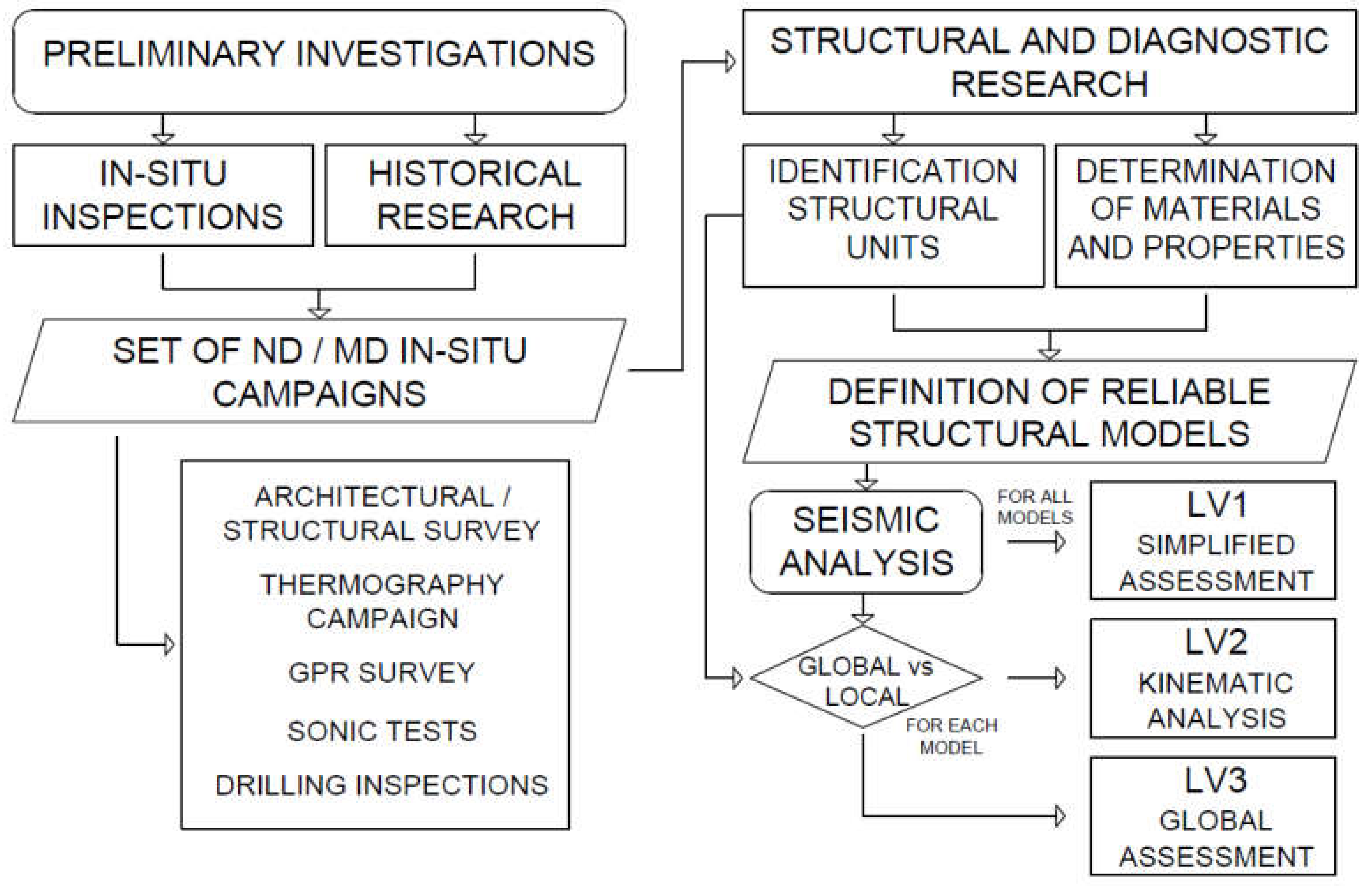
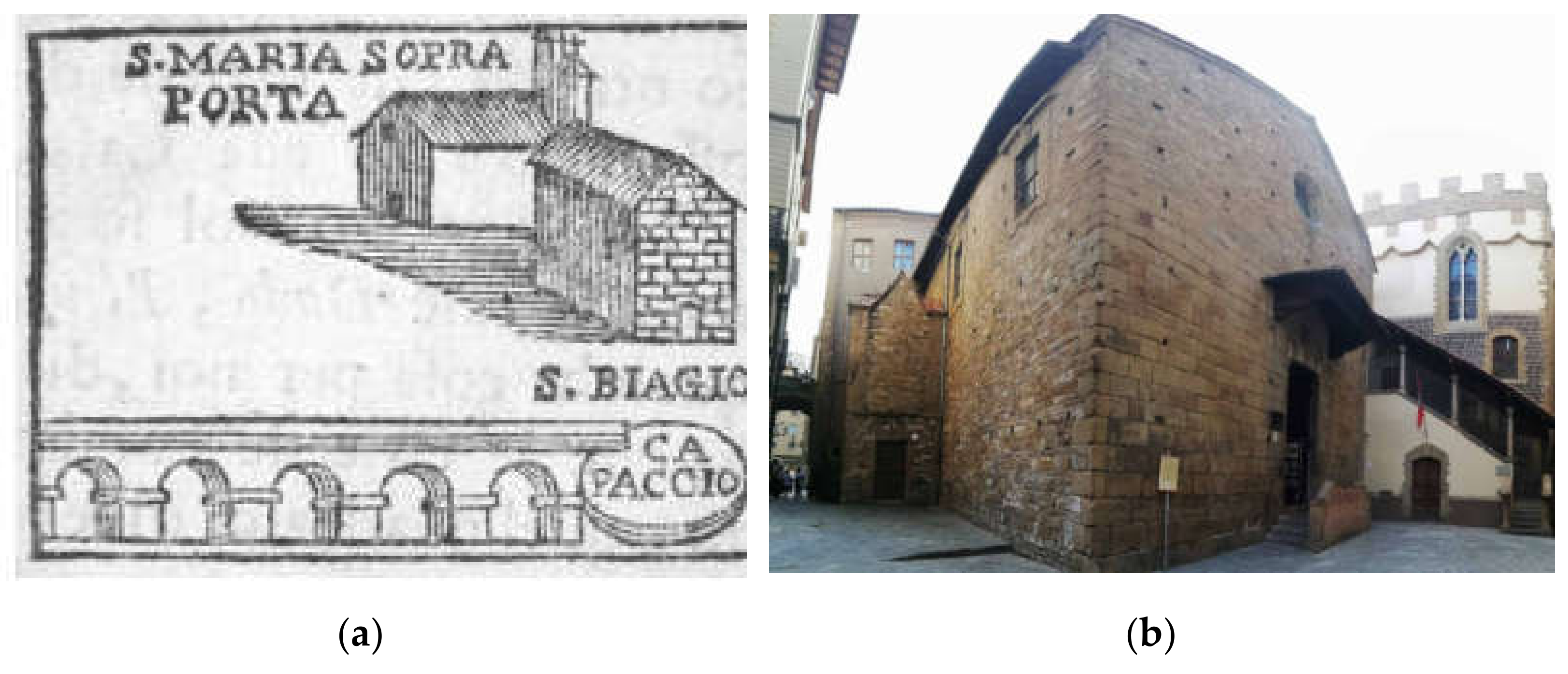
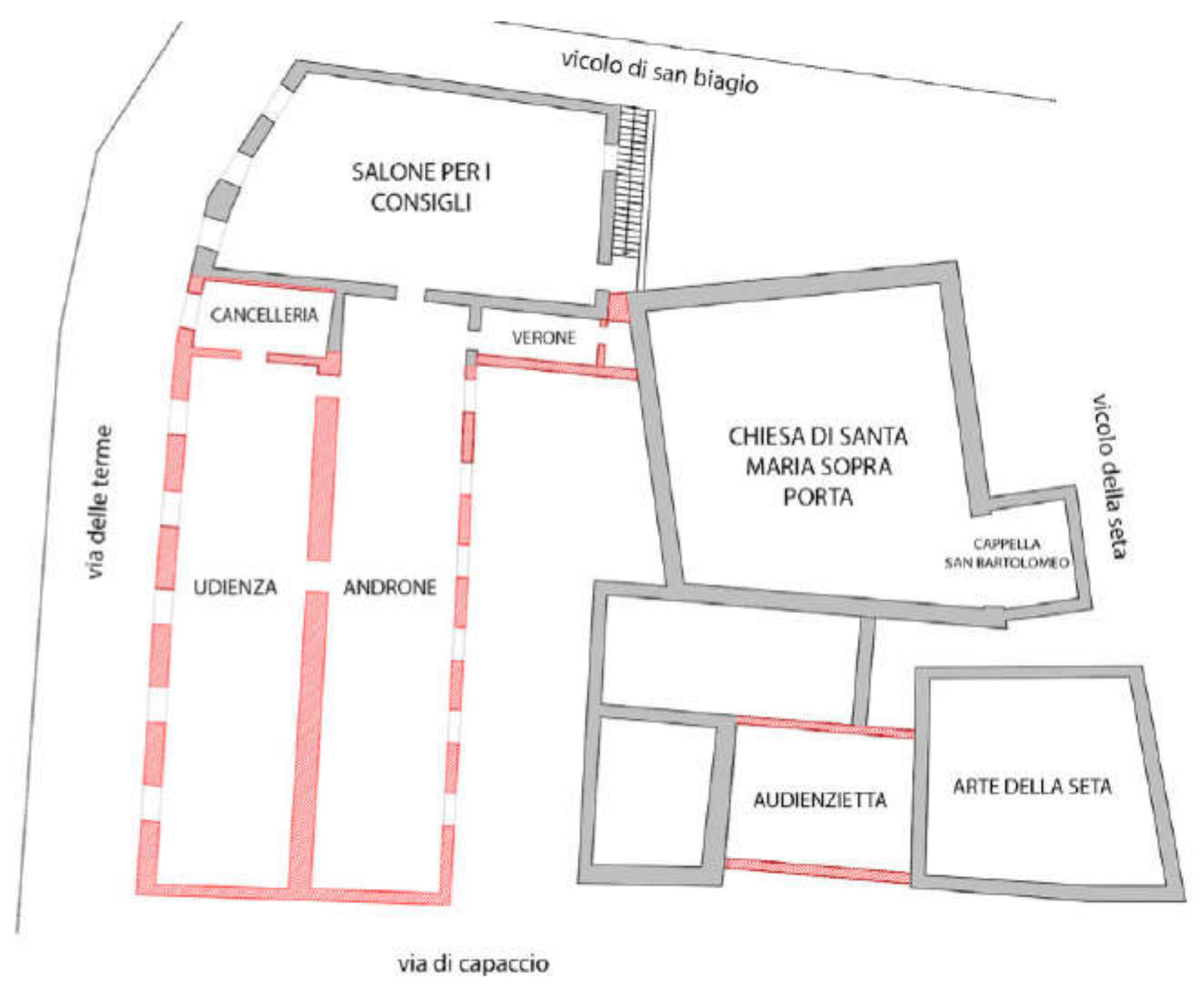
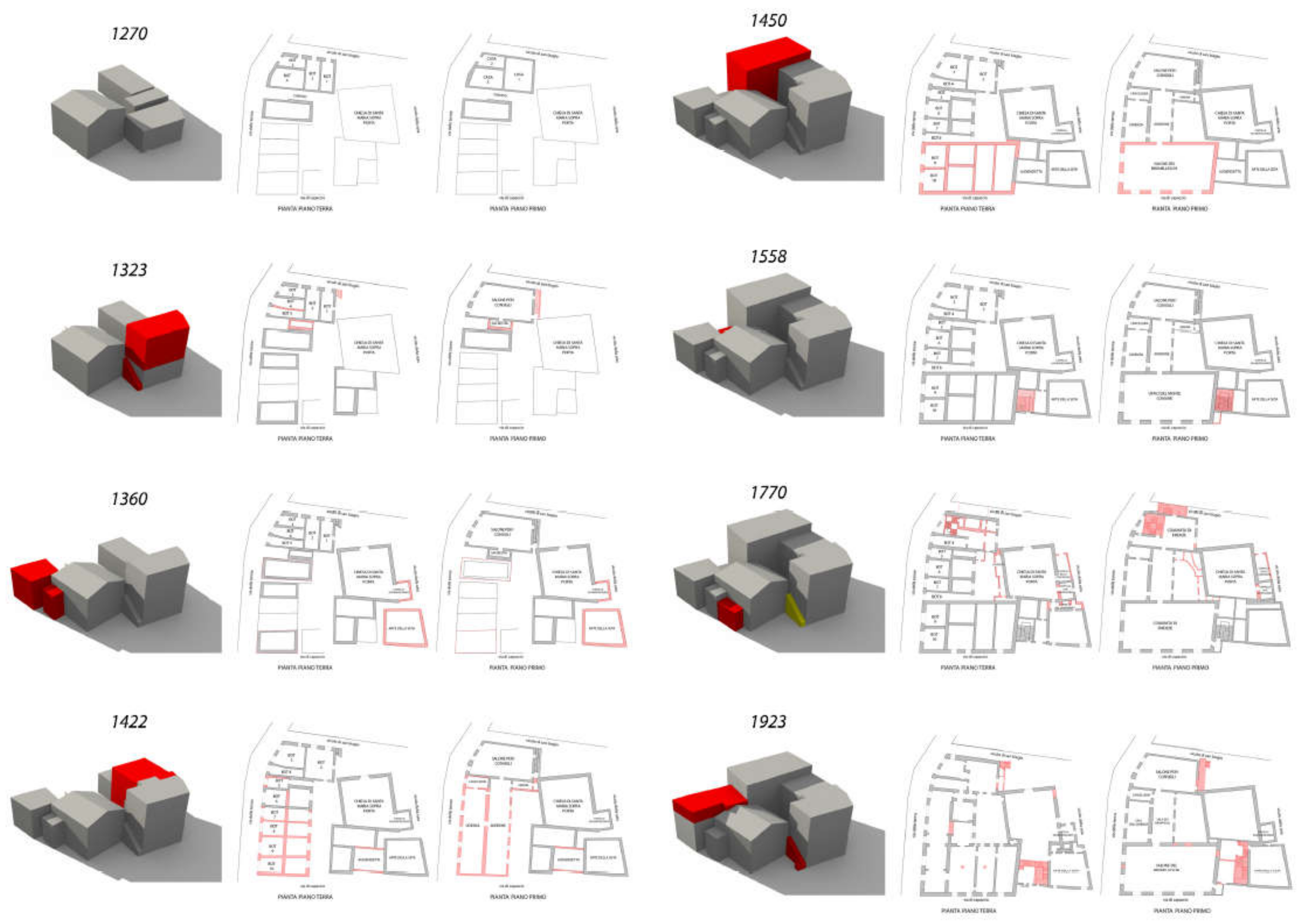
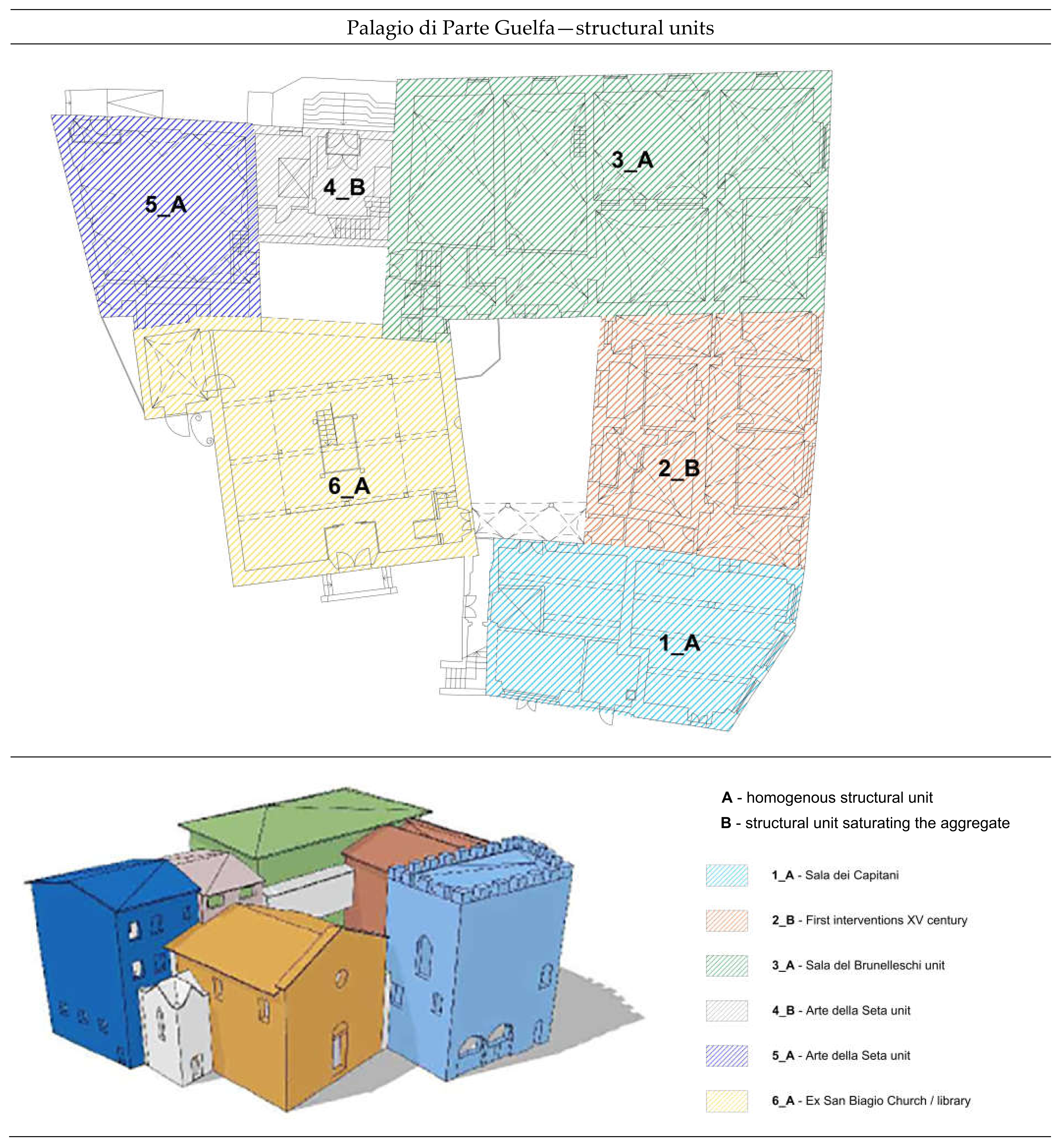
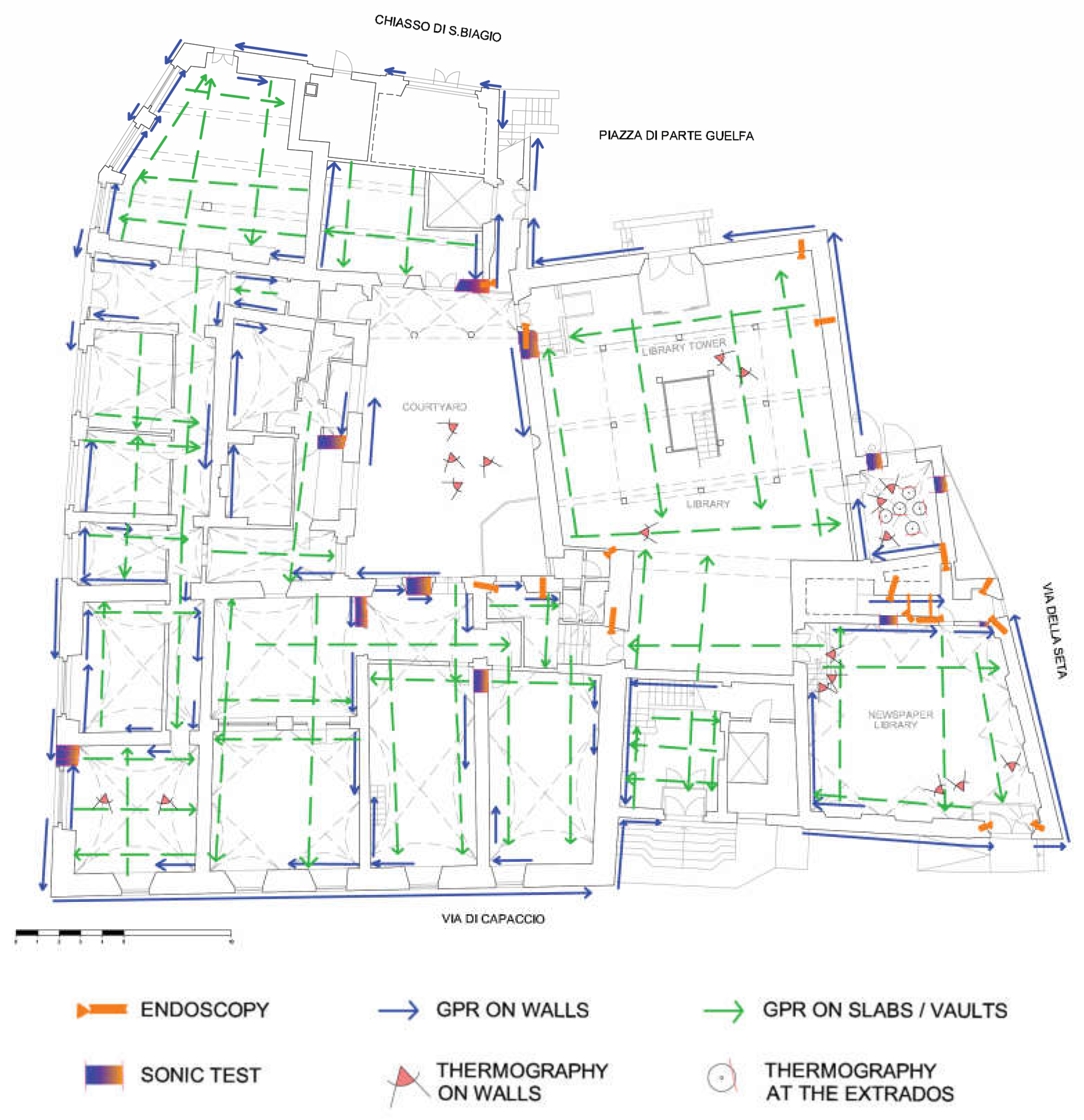

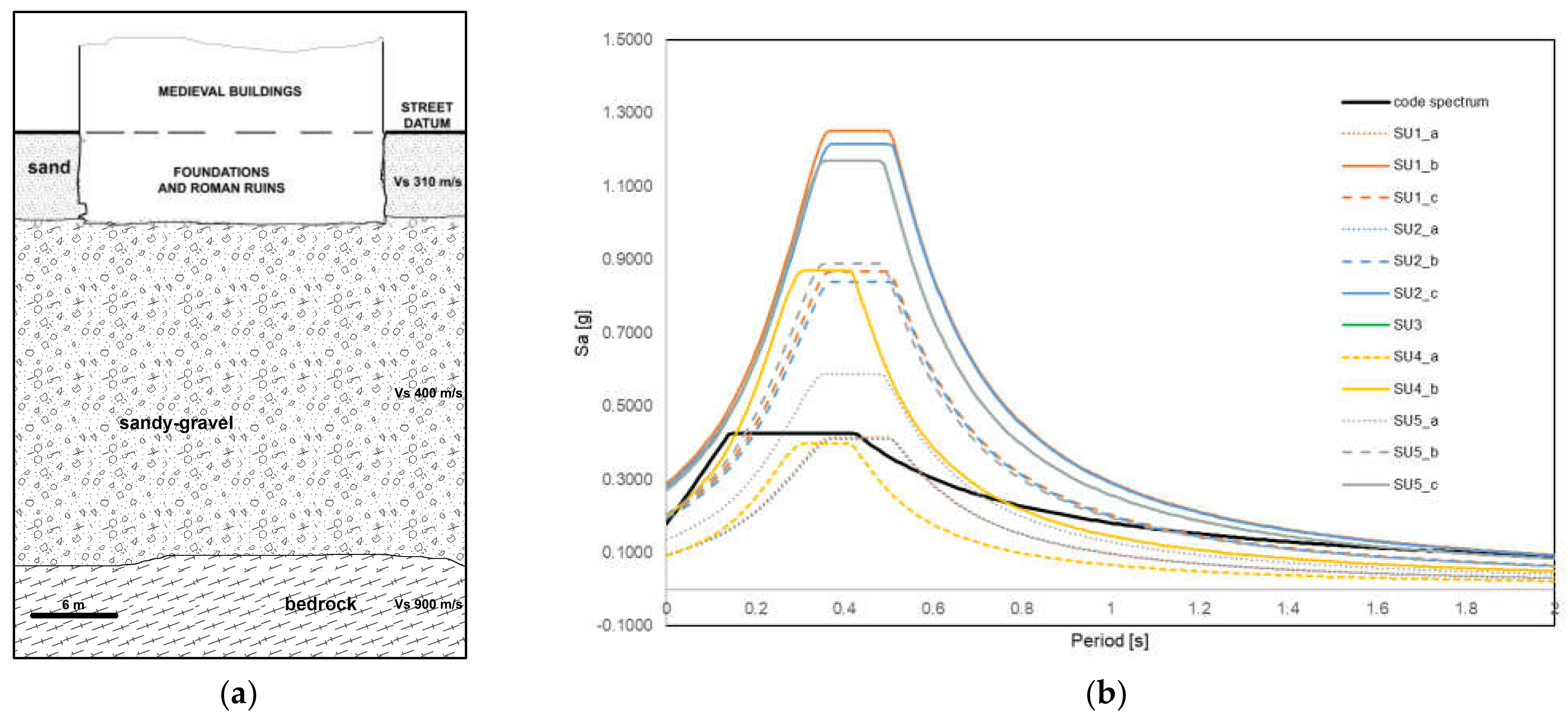
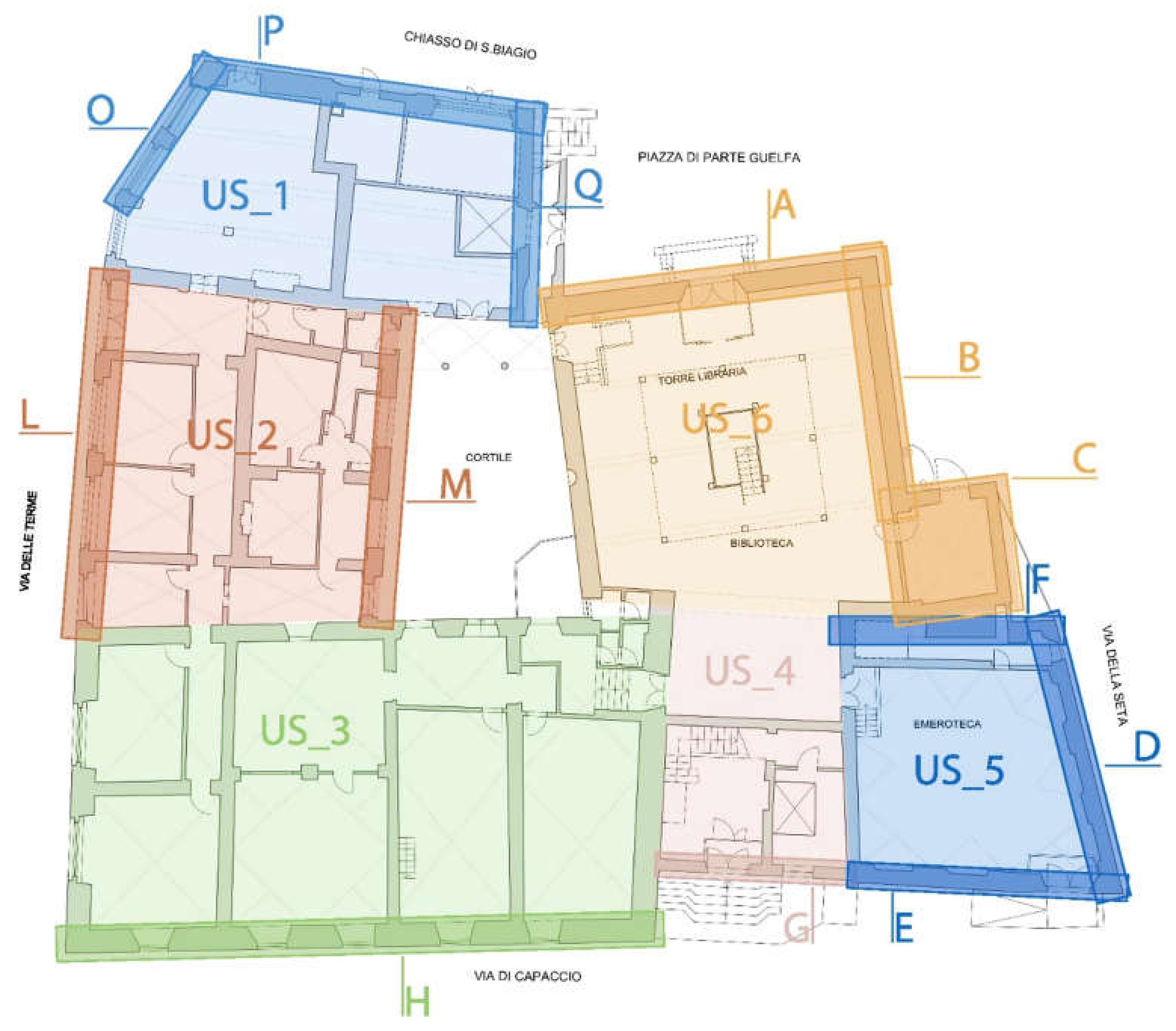
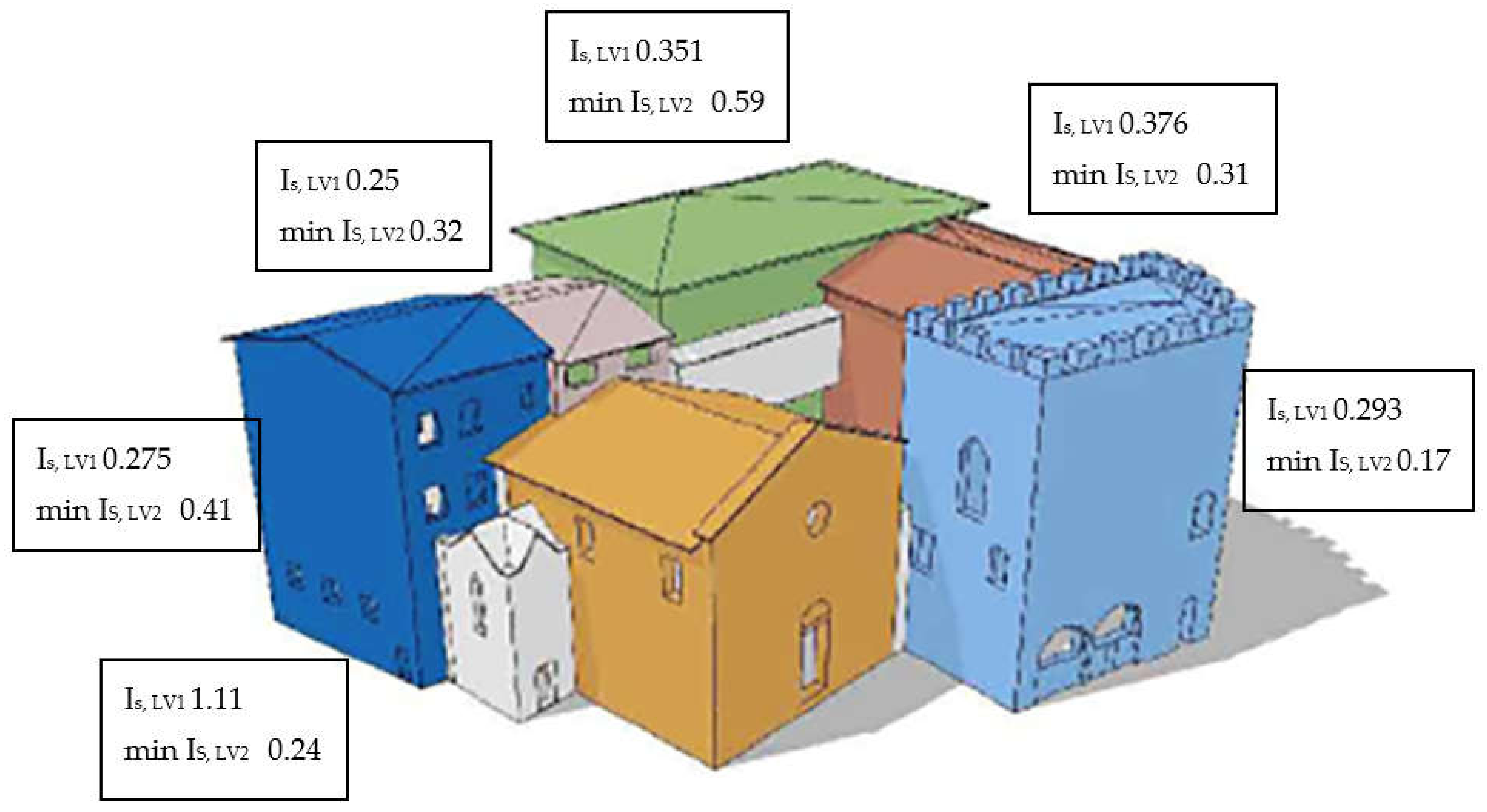
| Tuscany Region [71] | Italian Code [29] | |||
|---|---|---|---|---|
| A | Masonry comprising an inner nucleus and two external leaves realized with variable stones, poorly disposed and without a connection between the two sides of the panel | 1 | Rubble stone | |
| B | Masonry comprising an inner nucleus and two external leaves realized with stones of regular dimensions, well-disposed and with connections between the two sides of the panel, horizontal layers of chiselled stones or clay bricks | 2 | Rough blocks with non-homogeneous thickness of the external faces | |
| C | Rough stone masonry with irregularities | 3 | Split stone with good textural disposition | |
| D | Rough stone masonry with horizontal layers of chiselled stones or clay bricks | 4 | Irregular soft stone (tuff, calcarenite etc.) | |
| E | Rubble stone masonry of variable dimensions without horizontally chiselled stones or clay bricks | 5 | Regular blocks made of soft stone (tuff, calcarenite etc.) | |
| F | Rubble stone masonry of variable dimensions with horizontally chiselled stones or clay bricks | 6 | Stone square blocks | |
| G | One-leaf masonry made by blocks of tuff of chiselled stones with constant dimensions | 7 | Clay bricks and lime mortar | |
| H-I | Prefabricated concrete blocks with ordinary or light homogenous inserts | 8 | Semi-full bricks with cement mortar (ex. Double UNI with the hollow part ≤40%) | |
| L | Full or semi-full clay masonry | |||
| M | Clay block masonry with the dimensions of the hole being greater than 45% | |||
| T | Mixed structure, i.e., a combination of one of more of the previous typologies | |||
| U | Confined masonry | |||
| V | Reinforced masonry | |||
| Z | Consolidated masonry (injection of mortar, reinforced concrete layers, etc.) | |||
| Tuscany Region [71] | Italian Code [29] | ||
|---|---|---|---|
| B | Masonry comprising an inner nucleus and two external leaves realized with stones of regular dimensions, well-disposed and with connections between the two sides of the panel, horizontal layers of chiselled stone or clay bricks | 2 | Rough block with non-homogeneous thickness of the external faces |
| C | Rough stone masonry with irregularities | 2 | Rough block with non-homogeneous thickness of the external faces |
| D | Rough stone masonry with horizontal layers of chiselled stone or clay bricks | 3 | Split stones with good textural disposition |
| L | Full or semi-full clay masonry | 7 | Clay bricks and lime mortar masonry |
| S.U. | 1 | 2 | 3 | 4 | 5 | 6 |
| Is,SLV | 0.293 | 0.376 | 0.351 | 0.250 | 0.275 | 1.11 |
| Structural Units | Macro-Element | Mechanism | Is,SLV | T (kN) | Is,SLV |
|---|---|---|---|---|---|
| US_6 | A | OT1 | 0.6 | 80 | 1 |
| C | COT side1 | 0.24 | 18.4 | 1.01 | |
| COT side 2 | 0.4 | 18.4 | 1.01 | ||
| US_5 | D | VF 2+3 | 0.95 | 80 | 1.03 |
| COT 2+3 | 0.69 | 92 | 1.01 | ||
| COT 3 | 0.72 | 30 | 1.01 | ||
| TOP | 0.81 | 10 | 1.04 | ||
| E | COT1+2+3 | 0.41 | 135 | 1 | |
| COT 2+3 | 0.87 | 29 | 1.01 | ||
| COT 3 | 0.76 | 40 | 1.03 | ||
| VF 1+2 | 0.41 | 170 | 1.06 | ||
| VF 2+3 | 0.97 | 10 | 1.08 | ||
| F | COT 3 | 0.71 | 24 | 1.02 | |
| US_4 | G | COT1+2+3 | 0.32 | 50 | 1.11 |
| COT 2+3 | 0.42 | 35 | 1.08 | ||
| COT 3 | 0.13 | 12 | 1.04 | ||
| VF 1+2 | 1.06 | ||||
| VF 2+3 | 0.54 | 35 | 1.02 | ||
| US_3 | H | OT | 0.59 | 200 | 1.03 |
| COT1+2+3 | 1.24 | ||||
| COT2+3 | 1 | ||||
| COT2+3/2 | 1.62 | ||||
| COT3 | 1.07 | ||||
| US_2 | L | COT1+2+3+4 | 0.31 | 174 | 1 |
| COT 2+3+4 | 0.52 | 75 | 1.01 | ||
| COT 3+4 | 0.33 | 159 | 1.01 | ||
| COT 4 | 0.59 | 50 | 1.06 | ||
| VF 1+2 | 1.12 | ||||
| VF 2+3+4 | 0.98 | 10 | 1.02 | ||
| M | COT1+2+3 | 0.24 | 150 | 1.03 | |
| COT 2+3 | 0.52 | 96 | 1.01 | ||
| COT 3 | 0.42 | 90 | 1.04 | ||
| VF 1+2 | 0.29 | 90 | 1.08 | ||
| VF 2+3 | 0.96 | 15 | 1.04 | ||
| US_1 | O | COT1+2+3 | 0.57 | 60 | 1.03 |
| COT 2+3 | 0.6 | 50 | 1.03 | ||
| P | COT1+2+3 | 0.91 | 40 | 1.03 | |
| COT 2+3 | 0.82 | 60 | 1.05 | ||
| COT 3 | 0.17 | ||||
| Top Merlon | 1.18 | ||||
| Q | COT 2+3 | 0.8 | 30 | 1.01 |
Publisher’s Note: MDPI stays neutral with regard to jurisdictional claims in published maps and institutional affiliations. |
© 2022 by the authors. Licensee MDPI, Basel, Switzerland. This article is an open access article distributed under the terms and conditions of the Creative Commons Attribution (CC BY) license (https://creativecommons.org/licenses/by/4.0/).
Share and Cite
Caranti, A.; Cardinali, V.; Ciuffreda, A.L.; Coli, M.; De Stefano, M.; Le Pera, E.; Tanganelli, M. Seismic Vulnerability Assessment of a Medieval Urban Cluster Identified as a Complex Historical Palace: Palagio di Parte Guelfa in Florence. Heritage 2022, 5, 4204-4227. https://doi.org/10.3390/heritage5040217
Caranti A, Cardinali V, Ciuffreda AL, Coli M, De Stefano M, Le Pera E, Tanganelli M. Seismic Vulnerability Assessment of a Medieval Urban Cluster Identified as a Complex Historical Palace: Palagio di Parte Guelfa in Florence. Heritage. 2022; 5(4):4204-4227. https://doi.org/10.3390/heritage5040217
Chicago/Turabian StyleCaranti, Anna, Vieri Cardinali, Anna Livia Ciuffreda, Massimo Coli, Mario De Stefano, Elena Le Pera, and Marco Tanganelli. 2022. "Seismic Vulnerability Assessment of a Medieval Urban Cluster Identified as a Complex Historical Palace: Palagio di Parte Guelfa in Florence" Heritage 5, no. 4: 4204-4227. https://doi.org/10.3390/heritage5040217







